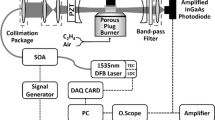Abstract
IN the course of investigations on the electron concentration produced by evaporation of electrons from the carbon particles in the luminous flames of acetylene and air, it was found that the method of microwave attenuation described by Belcher and Sugden1 was not sufficiently sensitive. A more sensitive method of obtaining this concentration is to determine the conductivity of the flame by measuring the change in characteristics of a cavity resonator when the flame is inserted in it.
Similar content being viewed by others
References
Belcher and Sugden, Proc. Roy. Soc., A, 201, 480 (1950).
Adler, J. App. Phys., 20, 1125 (1949).
Margenau, Phys. Rev., 69, 508 (1945).
Kurlbaum, Phys. Z., 3, 187 (1902).
Lewis and von Elbe, “Combustion, Flames and Explosions of Gases”, chapter 19 (Camb. Univ. Press, 1938).
Fowler and Guggenheim, “Statistical Thermodynamics”, par. 1112, (Camb. Univ. Press, 1939).
Reimann, Proc. Phys. Soc., 50, 496 (1938).
Author information
Authors and Affiliations
Rights and permissions
About this article
Cite this article
SUGDEN, T., THRUSH, B. A Cavity Resonator Method for Electron Concentration in Flames. Nature 168, 703–704 (1951). https://doi.org/10.1038/168703a0
Issue Date:
DOI: https://doi.org/10.1038/168703a0
- Springer Nature Limited
This article is cited by
-
Change of Ionization Mechanism in the Welding Fume Plasma from Gas Metal Arc Welding
Aerosol Science and Engineering (2019)





